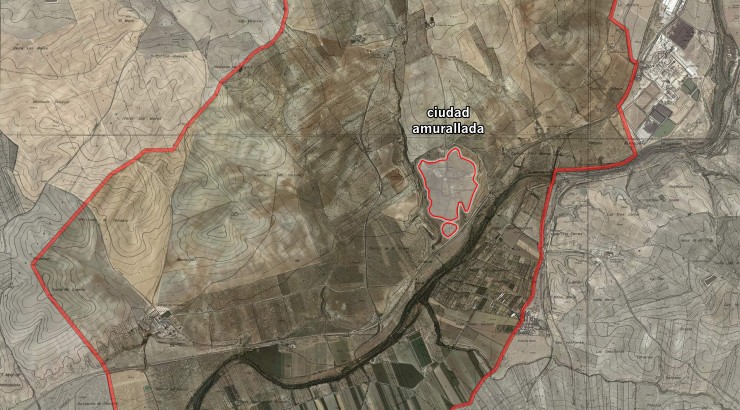Faculty Research in Ancient Cástulo
July 30, 2014

The ancient city itself is labeled “Ciudad amurallada”; the outer red ring shows the territory controlled by the city.
Today, Wednesday, July 30, 2014, marks two weeks since my arrival in the city of Linares (in the province of Jaén, Spain) and starting to work alongside members of the
FORVM MMX team
at the site of ancient Cástulo. I first came to Cástulo two years ago when I was working on my book,
Consumerism in the Ancient World
. At that time, the leader of the project, Marcelo Castro López, was kind enough to suggest that if I ever wanted to collaborate, I should let him know. Once the book was published at the end of 2013, I wrote to Dr. Castro and asked whether he was still interested in working together, and he invited me to come to Spain. My work here this summer is to figure out what it might be possible to do in future seasons of excavation — and how I might be able to get Chapman students involved.
Before talking about my specific research interests at the site, it’s worth explaining why the city was important in antiquity. The walled urban center occupied a plateau overlooking the Guadalimar River (which joins the main river of southern Spain, the Guadalquivir, just a few kilometers away, pictured above).
The surrounding region was rich with silver and lead mines that were exploited in ancient times and even up until recent decades. The site thus controlled significant resources and was a major crossroads for trade and interaction. Cástulo was founded by an indigenous Iberian population by the seventh century BCE; there is clear evidence for contact with traders from Phoenicia, in the eastern Mediterranean from the earliest period. As the capital of a region known as Oretania, and due to its mines, Cástulo became an important ally for Carthage against Rome in the Second Punic War (218-201 BCE). The Carthaginian general Hannibal’s wife came from Cástulo, and the town apparently supplied him 300 pounds of silver a day to support his military endeavors. After the Roman victory, Cástulo had a long and prosperous history and it was also prominent in the early Christian and Visigothic periods. An Islamic settlement named Qastuluna was later founded nearby.
Spanish archaeologists began excavations in the area around Cástulo in the 1960’s, continuing through the 1980’s. They found tombs of all periods in the hills surrounding the town, filled with the imports that had been traded for Cástulo’s metals. They also found temple by the river that dated to the town’s earliest days; it looked like a Phoenician temple, and thus seems to be a strong indication of the mixing of cultures through commerce. Finally, in the only work to take place within the city before 2011, they found traces of the city’s fortifications from the Iberian and Roman periods, and a late Roman bath-complex.
The current project is working to clarify all phases of the site’s occupation through carefully-targeted excavation. There are several specific goals: to identify the town’s forum during the Roman period; to understand the management of water at the site; to reveal the sequence of Iberian urbanism at Cástulo; and to investigate the area of the ancient port.
In 2011, FORVM MMX started trenches in the area thought to be the location of the forum. Instead, they uncovered several Iberian and Roman structures. The most spectacular of these was a building of late first-century CE date that was decorated with an almost-complete mosaic measuring 72 m
2
.
It depicts romantic myths and personifications of seasons.
You can see extremely high-resolution images of the mosaic here
. They have also identified evidence, in the form of clay lamps decorated with images of menorahs, for the existence of a Jewish community in the city — a rarity in Spain in the late antique period.
Ancient Cástulo Part Two
|
Ancient Cástulo Part Three
|
Ancient Cástulo Part Four
|
Ancient Cástulo Part Five




